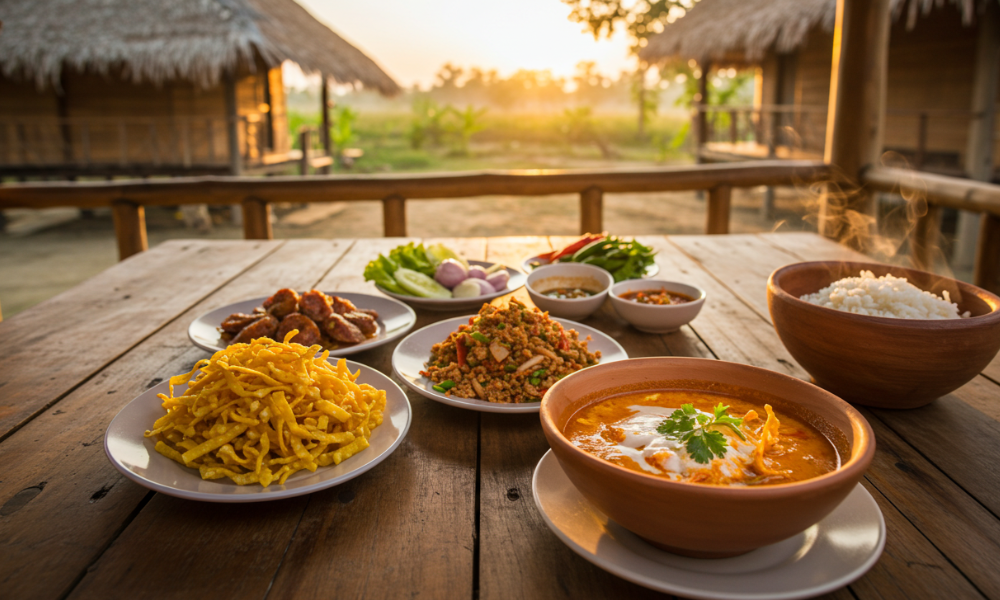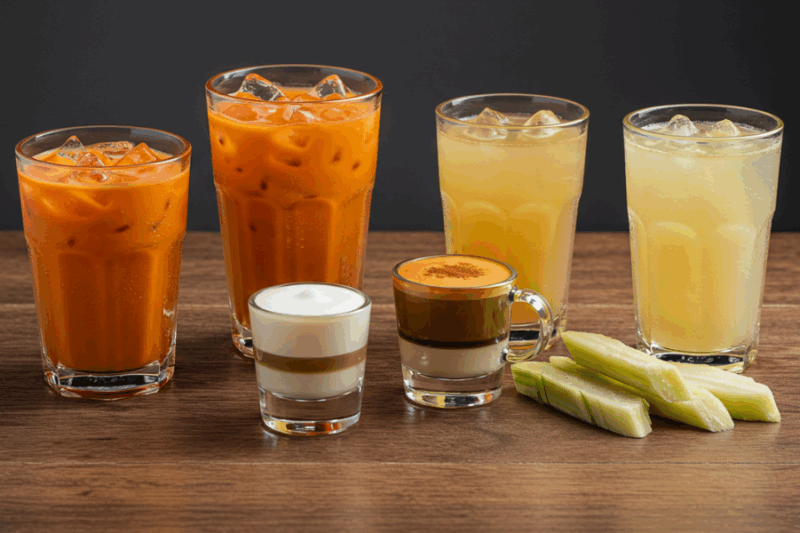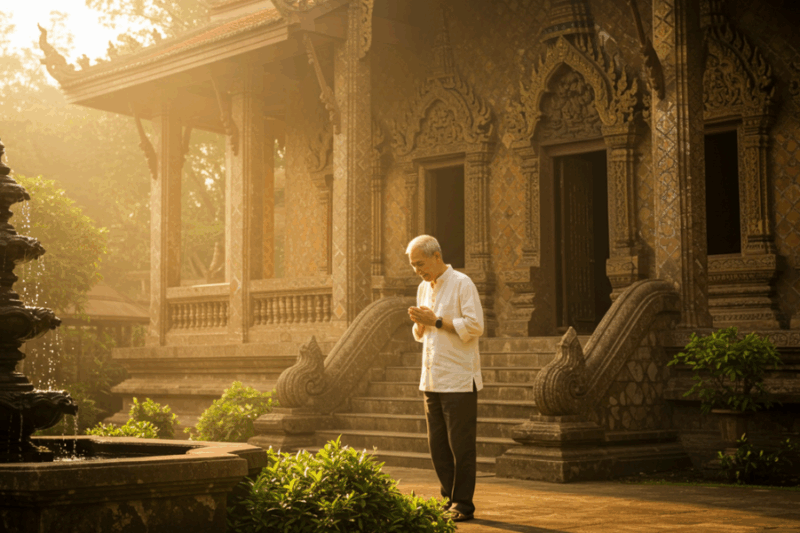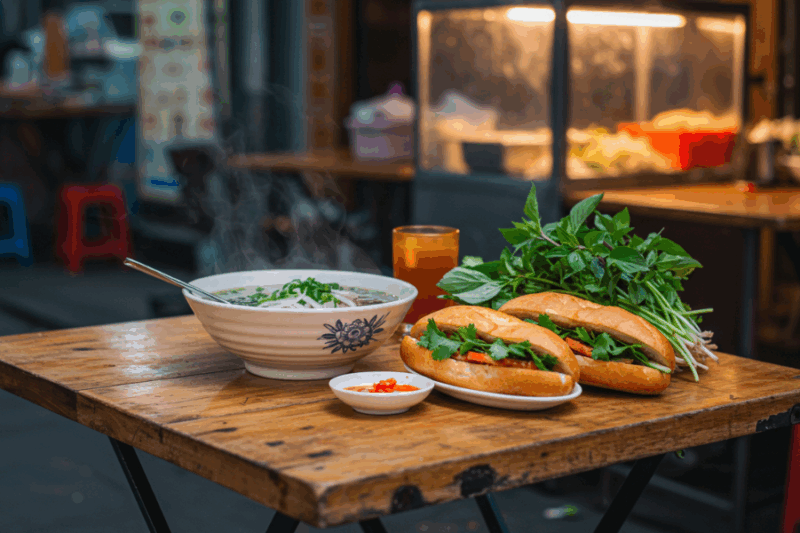Northern Thailand, with its lush mountains, vibrant markets, and rich cultural heritage, offers a culinary scene distinct from the rest of the country. Influenced by Lanna (Lan Na) traditions, neighboring Myanmar, Laos, and China, and the region’s cooler climate, Northern Thai cuisine is bold, earthy, and deeply tied to local ingredients. For minimalist travelers, exploring these traditional foods is a perfect way to immerse in culture without needing much—just an appetite and curiosity. From fiery salads to fragrant curries, here’s a guide to the must-try dishes of Northern Thailand, focusing on Chiang Mai, Chiang Rai, and the surrounding areas, with tips to enjoy them on a budget.

1. Khao Soi (Northern Thai Curry Noodle Soup)
Khao soi is the iconic dish of Northern Thailand, a creamy coconut curry noodle soup that balances spicy, sweet, and tangy flavors. Made with egg noodles, a rich broth of coconut milk, red curry paste, and turmeric, it’s typically topped with crispy fried noodles, cilantro, and lime. Protein options include chicken, pork, or beef, with vegetarian versions available. The dish reflects Lanna and Muslim influences, with roots in Myanmar’s Shan cuisine. A bowl at a local market like Warorot in Chiang Mai costs 40–60 THB ($1–2 USD), making it a filling, affordable meal for travelers packing light.
Why Try: Comforting yet complex; a Northern Thai staple.
Where to Eat: Khao Soi Khun Yai (Sri Poom Rd, Chiang Mai) for authentic, budget-friendly bowls.
Tip: Squeeze lime and add pickled mustard greens for extra zing.
2. Sai Oua (Northern Thai Sausage)
Sai oua, or Northern Thai sausage, is a smoky, spicy delight packed with pork, lemongrass, galangal, kaffir lime leaves, and red curry paste. Grilled over charcoal, it’s often served sliced with sticky rice and fresh herbs. The sausage’s bold flavors make it a perfect snack or meal component, costing 20–50 THB ($0.50–1.50) at street stalls. For minimalist travelers, it’s portable and pairs well with a small portion of sticky rice, keeping your carry-on meal plan simple.
Why Try: Bursting with herbs and spices; great for sharing.
Where to Eat: Chiang Mai Gate Night Market for freshly grilled sai oua.
Tip: Pair with nam prik ong (below) for a complete Northern Thai experience.
3. Nam Prik Ong (Spicy Pork and Tomato Dip)
Nam prik ong is a fiery, tangy dip made from minced pork, tomatoes, dried chilies, and shrimp paste, served with fresh vegetables like cucumber, cabbage, or long beans. It’s a communal dish, often eaten with sticky rice, reflecting Northern Thailand’s love for bold relishes. A small portion with veggies costs 30–50 THB ($1–1.50) at local eateries. For travelers, it’s a low-cost, nutrient-rich option that requires no extra gear—just dip and enjoy.
Why Try: Savory and spicy; showcases local produce.
Where to Eat: Huen Phen (Chiang Mai) for an authentic version.
Tip: Ask for mild if you’re sensitive to spice, as Northern dips can be intense.
4. Laab Kua (Northern Thai Spicy Meat Salad)
Unlike the sour, lime-heavy laab of Northeast Thailand, Northern Thai laab kua is earthier, featuring minced pork, chicken, or buffalo mixed with roasted spices, dried chilies, and fresh herbs like mint and culantro. It’s often served raw (laab dip) or cooked, accompanied by sticky rice and raw veggies. A plate costs 40–80 THB ($1–2.50) at markets or small restaurants. Minimalist travelers will appreciate its simplicity—no utensils needed, just scoop with sticky rice.
Why Try: Bold, aromatic, and deeply regional.
Where to Eat: Talat Ton Phayom Market (Chiang Mai) for fresh, affordable laab.
Tip: Stick to cooked laab kua if you’re wary of raw meat dishes.
5. Kaeng Hang Lay (Northern Thai Pork Curry)
Kaeng hang lay is a slow-cooked pork curry with Burmese influences, featuring tender pork belly and shoulder in a sweet-spicy sauce of tamarind, ginger, turmeric, and curry powder. Unlike coconut-based curries, it’s lighter but richly flavored, often served with sticky rice. A portion costs 50–100 THB ($1.50–3) at local restaurants. For travelers, it’s a hearty, mess-free meal that pairs well with a minimalist dining approach—just a small bowl and rice suffice.
Why Try: Unique sweet-tangy profile; a Lanna classic.
Where to Eat: Tong Tem Toh (Chiang Mai) for a cozy, authentic setting.
Tip: Order with roti for a delightful twist if available.
6. Tam Khanun (Jackfruit Salad)
Tam khanun is a spicy salad made from young, unripe jackfruit, boiled until tender, then pounded with chili paste, tomatoes, and herbs. It’s similar to som tam (papaya salad) but uses jackfruit’s unique texture, offering a vegetarian-friendly option. A plate costs 30–50 THB ($1–1.50) at markets. For minimalist travelers, it’s a light, refreshing dish that’s easy to eat on the go, requiring no extra packing.
Why Try: Fresh, spicy, and plant-based; perfect for hot days.
Where to Eat: Chiang Rai Night Bazaar for vibrant market vibes.
Tip: Request “mai pet” (not spicy) if you prefer milder flavors.
7. Sticky Rice (Khao Niew)
Sticky rice, or khao niew, is the backbone of Northern Thai meals, served in small woven baskets or plastic bags. It’s eaten with hands, rolled into balls, and dipped into dishes like nam prik ong or laab. A portion costs 10–20 THB ($0.30–0.60), making it a budget staple. For travelers, it’s the ultimate minimalist food—portable, filling, and zero waste when bought from street vendors.
Why Try: Essential to Northern Thai dining; cheap and versatile.
Where to Eat: Any local market or roadside stall in Chiang Mai or Chiang Rai.
Tip: Store in a reusable silicone bag to keep fresh during day trips.
Tips for Enjoying Northern Thai Food as a Minimalist Traveler
- Eat Local: Visit markets like Warorot (Chiang Mai) or Ban Du (Chiang Rai) for authentic, affordable dishes (20–60 THB per item).
- Pack Light: Bring a reusable water bottle and small cloth napkin to avoid waste; most dishes are handheld or spoon-based, so no extra utensils needed.
- Budget Wisely: A full meal (main, side, sticky rice) costs $2–5 USD at markets, saving money for experiences like temple visits.
- Try Cooking Classes: Learn to make khao soi or nam prik ong in a half-day class (500–1000 THB, $15–30) for a cultural souvenir that doesn’t clutter your bag.
- Respect Spice Levels: Northern Thai food can be fiery; ask for “pet nit noi” (a little spicy) to ease in.
- Explore Street Food: Night markets offer variety and freshness; arrive early (6–8 PM) for the best selection.
- Check Hygiene: Stick to busy stalls with high turnover to ensure fresh, safe food.
Why Northern Thai Food Suits Minimalist Travel
Northern Thailand’s traditional foods are perfect for minimalist travelers: they’re affordable, widely available, and require minimal gear to enjoy. Dishes like khao soi and sai oua deliver bold flavors without the need for fancy restaurants, while market stalls and street vendors keep costs low and experiences authentic. By focusing on local eats, you reduce your environmental footprint, support small businesses, and immerse in Lanna culture without physical or financial baggage.



